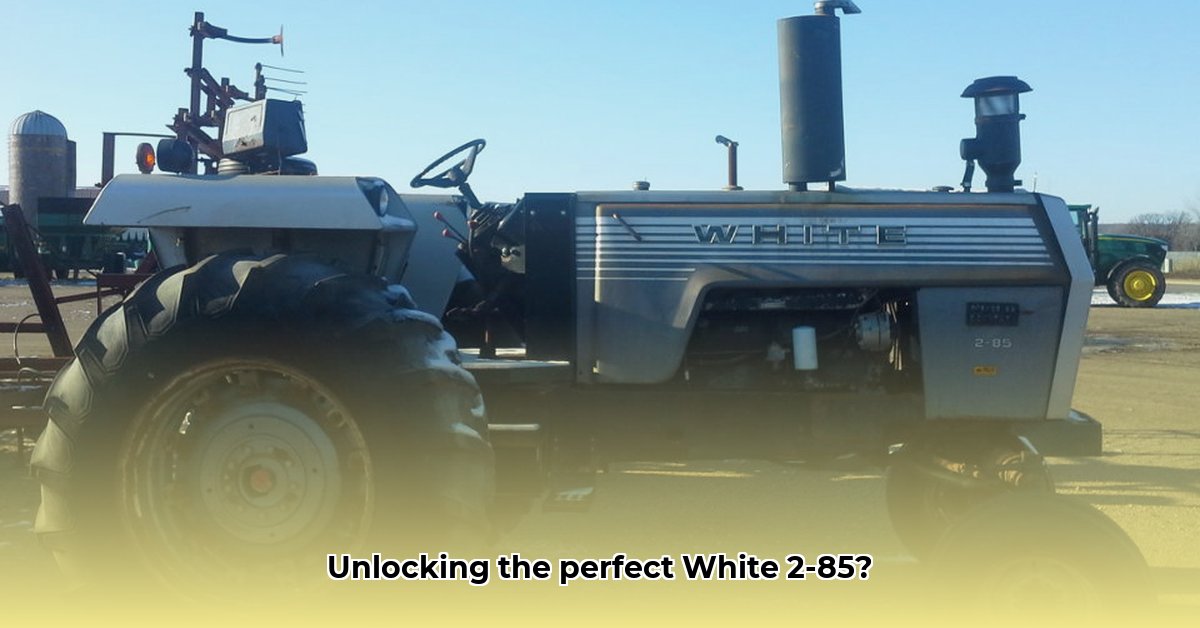
The White 2-85 tractor, a reliable workhorse from the late 1970s and early 1980s, offers a compelling blend of ruggedness and classic appeal. Highly sought after by collectors and farmers, understanding the nuances of acquiring and maintaining one requires careful consideration. This guide provides a comprehensive walkthrough, from initial search to ongoing maintenance. For additional resources on finding affordable tractors, check out this helpful website.
Understanding the White 2-85 Market: Value and Variables
The price of a used White 2-85 varies significantly, ranging from approximately $5,000 to over $14,000. Several factors influence this range, mirroring the classic car market. A meticulously maintained tractor with low operating hours will naturally command a higher price than one showing considerable wear. Additional features, such as a front-end loader, also significantly impact value. Therefore, a thorough assessment of the tractor's condition is crucial before making a purchase. Are you buying a well-preserved classic, or a restoration project? The price difference will reflect this distinction.
Assessing the Tractor's Condition: A Practical Inspection
Before committing to a purchase, conduct a thorough inspection. Go beyond superficial scratches and minor rust; focus on potential mechanical problems. Look for engine leaks, hydraulic issues, and signs of excessive wear on key components. These are potential costly repairs. A pre-purchase inspection by a qualified mechanic specializing in vintage tractors is highly recommended. This professional assessment will identify hidden problems, providing a realistic appraisal of potential repair costs and saving you substantial money in the long run. Remember, a seemingly small issue can lead to large expenses.
Locating Your White 2-85: A Strategic Search
Finding your ideal White 2-85 requires diligent searching. Online marketplaces dedicated to farm equipment represent an excellent starting point. Don't rule out local auctions—often hidden gems await. Explore classified ads in agricultural publications and local newspapers. Word-of-mouth networks within collector communities can prove surprisingly effective, often revealing opportunities before they become publicly listed. Building relationships with other enthusiasts expands your reach significantly.
Capabilities and Considerations: A Balanced Perspective
The White 2-85 boasts a respectable 85 PTO horsepower, making it suitable for various tasks. Its robust construction and reliable performance are hallmarks of its era. However, as with any vintage equipment, certain factors must be considered. Parts availability can be challenging, and replacement parts may be more expensive than those for modern tractors. Establishing a relationship with a trustworthy mechanic experienced with older tractors is paramount for ongoing maintenance and repair. This proactive approach ensures your tractor's continued operation.
Maintaining Your White 2-85: A Proactive Approach
Maintaining your 2-85 requires more than just occasional oil changes. Regular maintenance and careful attention to detail are vital for its longevity. Consider it preventative care, preventing costly repairs in the future. Implement a routine schedule for fluid changes (engine oil, transmission fluid, hydraulic fluid). Regularly inspect belts, hoses, and other wear items. Address any issues promptly, before they escalate. A skilled mechanic can create a tailored maintenance plan based on your tractor's specific needs and usage.
White 2-85: Pros, Cons, and Informed Decision-Making
| Pros | Cons |
|---|---|
| Robust Construction, Relatively Affordable Price | Parts Sourcing Can Be Challenging |
| Powerful PTO Horsepower | Repair Costs Can Be Higher Than Modern Tractors |
| Potential for Appreciation as a Collectible | Simpler Mechanical Design (Can be advantageous & limiting) |
| Adaptable Fuel Tank Options | Unsynchronized Transmission |
Restoring a White 2-85: A Rewarding Yet Demanding Undertaking
Restoring a White 2-85 is a significant project, demanding patience, mechanical aptitude, and a substantial budget. Parts sourcing can be extremely challenging. Before embarking on a restoration, carefully assess your skills and resources. Is this a project you can realistically complete? If so, the rewards of owning a beautifully restored piece of agricultural history are immense.
Finding Replacement Parts: A Step-by-Step Guide
Securing parts for a White 2-85 can be challenging, but not insurmountable. Prioritize repair and reuse to extend your tractor's life and minimize environmental impact.
Steps to Locating Parts:
- Precise Identification: Determine the exact part needed using your owner's manual or online resources.
- Online Search: Utilize specialized online marketplaces focusing on vintage tractor parts.
- Online Communities: Engage with online forums and Facebook groups dedicated to White 2-85 owners.
- Local Suppliers: Contact local tractor parts suppliers; they may have used parts or valuable leads.
- Junkyards and Salvage Yards: Explore junkyards and salvage yards as potential sources of used parts.
- Alternative Solutions: Consider adapting parts from similar models or utilizing 3D printing if necessary.
Conclusion: Embarking on Your White 2-85 Journey
The decision to purchase a White 2-85 should be based on your needs and realistic expectations. A well-maintained tractor offers years of reliable service. However, understanding the potential challenges regarding parts and repair costs is essential. By carefully assessing the condition, cost, and parts availability, you can increase your chances of acquiring a tractor that brings years of enjoyment.